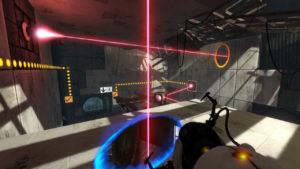For this critical play, I chose to play Portal, a favorite game of mine that I find myself coming back to again and again. In the game, you play as a robot testing prototype (when in co-op mode — in single-player, you are actually a human) whose job it is to solve portal-based puzzles for your creators/overlords Aperture Laboratories. The game seamlessly intertwines the novel physics-based portal mechanic, in which you can fire two ends of a wormhole from a portal gun through which you can pass objects, people, liquids, and even laser light, with a dystopian and slightly creepy test subject vs experimenter plot line which is explained to you by a snarky disembodied voice. In Portal, I think that the mechanics of the puzzle significantly alter and enhance the experience of the game, and are fundamentally the reason why I love it so much. Specifically, I think that the physicality and the consistency of the mechanics are what make it so appealing and fun to play.
The physicality of the portal mechanic is, in my opinion, the most important part, and is really what brings the whole game together and makes it so satisfying and fun to play. By physicality, I mean that the portals preserve physical quantities such as momentum and velocity, for anything that passes through them. These quantities are also transformed according to the angles at which the portals are placed — for example, if you throw a ball into a portal on the floor at some velocity, it will fly out of the other portal with the exact same velocity, straight up if the out portal is also on the floor, or at an angle if the out portal is at some angle. Not only does this please my physics-major brain, but it also improves the feeling of playing the game because it is intuitive, rather than random, what should happen to objects when they pass through portals. Because of this, players are quickly able to grasp and create complex portal-based sequences of events that involve objects flying and being launched at many different angles with different velocities and momenta. Because the mechanics so consistently follow the laws of real world physics, players are able to apply their real-world intuition to solve harder puzzles, which is more satisfying. By providing the player with tools they are able to use, and use well, we can give them the challenge type of fun, and really stretch their puzzling mind.

This leads into my second reason why the mechanics of Portal are so fun, which is consistency. Every mechanic in the game, from the blue membranes which deactivate all portals and destroy all boxes and spheres, to the bouncy slime that you can incorporate into your solutions, is highly consistent. Each mechanic is also introduced one-by-one in a way that doesn’t baby the player, but allows them to toy around with each mechanic before being given another one. One of the most frustrating parts of bad puzzles for me is when puzzles are inconsistent or show nondeterministic behavior — we as humans learn by experience, so if we are shown incorrect behavior we will learn from it, even if it is wrong. Portal brings me joy because it is very consistent and never leads the player astray in a way that is frustrating. You can always have faith that your portal guns will work the way they always have, the liquid will always kill you, and you will always be able to find the exit under the “exit” sign.



